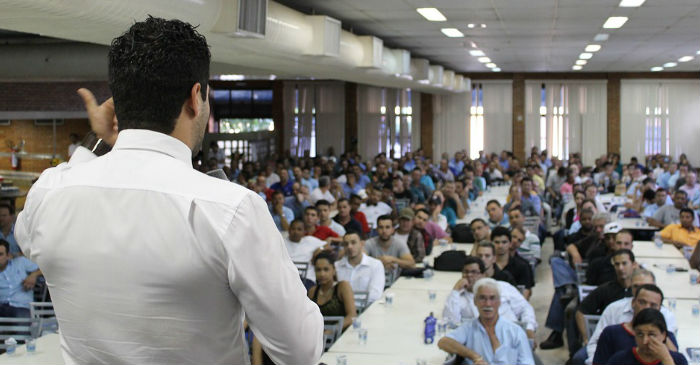
I get this question from audience members nearly every time I present – how much time should I spend to prepare for my presentation? Although it really depends on your presenting skills and comfort level with the information you’re sharing, I do have some rules of thumb when it comes to presentation practice. I call it the Speak Simple Presentation Time Breakdown. For every hour you present, you want to spend 10x that preparing! Preparing your presentation includes your strategy, brainstorm, outline, walk through, visual aid, practice, dress rehearsal, and even your debrief afterward. When you break out the steps, my 10x suggestion sounds more realistic. Unfortunately, most people spend a 1:1 ratio or less. Many speakers spend less than an hour to create a visual aid for their hour long presentation, and they skip the strategy and have no rehearsal either. I see this as disrespectful to your audience who gives
Read more

I’ve all faced a fear of public speaking, and it is the #1 reason why people look into my presentation education course, SpeakU, and the first thing I cover too. To no surprise, there are a lot of great fear of public speaking quotes out there. Some quotes are from well-known contemporaries, and others date back decades to the likes of Mark Twain, Ralph Waldo Emerson, and Henry Ford. Fear of Public Speaking Quotes “There are only two types of speakers in the world: the nervous and liars.” – Mark Twain, American author Twain is also quoted with a great line about preparing for speeches, “It usually takes me more than three weeks to prepare for a good impromptu speech.” “Some introverts are perfectly comfortable with public speaking; I’m not one of them.” Susan Cain, author or Quiet and TEDtalk on introverts “If you’re not comfortable with public speaking – and nobody
Read more

Any extraneous language that pads your sentences without adding any additional meaning equals a crutch word. Crutch words in presentations is bad because crutch words are also called “fillers”. Instead of taking those key pauses to let the audience digest what you are saying, those pauses are filled with empty words that weaken your overall message. Using crutch words takes away from the forcefulness and eloquence of your speech. It is thought that crutch words have been around since the beginning of spoken language and every person uses them on some scale and they vary depending on location and language! For example, umm if American’s favorite crutch word, the British use err, and Croats use ovay. Eliminating crutch words is the fastest way to improve oneself as a speaker! You become easier to understand and it will be easier for you to get your point across. It will also give you more confidence. Don’t
Read more

I worked at my local zoo for five years, and I joke that I’ve seen just about every presentation situation you can possibly imagine. Including presentations where I had no voice. Could you survive presentation mishaps? The summers were the busy season for outreach programs at the zoo as education programs were in high demand for visits to summer camps and library summer reading programs. I was talking to a group of over 100 youth girls at an all-female summer camp in town. I had made it through three of the animals, and I was preparing to take the last of the animals, which was an elderly red-shouldered hawk named Squawker. Being elderly, Squawker tended to sit in her travel box so that she was comfortable, rather than be positioned to take her easily out of the box. Because she was sitting backwards, I had to reach in to get her to
Read more

If you’ve spent any time on LinkedIn or Twitter, you’ve probably seen a graphic of a facet of business compared to an iceberg. People use icebergs because the majority of an iceberg’s mass is hidden below the surface of the water. This comparison is used when describing subjects like financial advising or even how to network because of the hidden, behind the scene elements that make that skill or product successful. Let me be the first to say that presentations are like icebergs too! The reason presentations are like icebergs is because the majority of the work happens away from the audience. When developing a presentation correctly, you should spend more time not presenting. The majority of the work for a presentation occurs during the preparation and practice phase, which happens behind closed doors. The only visible part of the process is the actual act of standing in front of others
Read more

When I meet someone for the first time and say that I’m a presentation coach, usually their response is flattering, and they talk how needed a public speaking coach is for businesses because they’ve seen a lot of bad, boring presentations. Almost always, they then ask, “How much does a presentation coach cost?” The answer really varies by market and based on the presentation coach’s experience; however, you’re usually looking at $2,000-10,000. I know that is a broad range and the price also varies depending on the scope of work. Some coaches charge per day, others by the presentation, and some charge a monthly rate. It is not uncommon to see a public speaking consultant charge $2,500 for a half-day session, plus travel costs. Regions like the Northeast United States and in major metro areas like San Francisco and Chicago, things cost more for coaching. In those areas, you probably
Read more

The majority of Americans are more scared of presentations than they are of spiders, snakes, falling, or flying. Jerry Seinfeld made the comedic reference that the majority of Americans would rather be lying in a casket than giving the eulogy. In my experience, there are five major ways to overcome the fear of public speaking, known as glossophobia. 1) Proper Preparation – Going through all of the steps of preparation can cure more than 80% of stage fright. This presentation preparation includes the presenter setting goals and gearing the information to achieve them, carefully constructing the content, and practicing the presentation multiple times. One of the major reasons for stage fright is because the presenter skips one or more of the preparation steps. Skipping any of the steps allows the presenter’s nerves to build and overwhelm the person because the presenter does not know what to say. 2) Visualization – It is
Read more

Setting goals for a presentation is not about the individual words you are going to say, but about the communication of your overall message. If you do not set clear presentation goals, your speech can easily go off topic. For example, I had a client that was pitching a bid to a large organization for a technology contract. When I asked what the goal of the presentation was, he promptly responded to win the contract. The answer was too broad and focused on him, so I questioned further. I found out that the competition was presenting after him, and the board would be making a decision at the end of the day based on the presentations (which followed a round of proposals). Just to win was not an appropriate goal; the true goal was to educate the board on the best criteria to look for when choosing a provider. If we
Read more

Studies show that the majority of what an audience receives from a presentation comes from the nonverbal cues, otherwise known as body language. Improper body movements and posture can change the undertone of your presentation quickly. This miscommunication can give your audience a very different message than what you intended. Much like a car, presentations have lots of different pieces to master in order to make success achievable. 1) Eye Contact – When involved in a conversation with friends, a person can confidently obtain and hold eye contact. Everything changes when the conversation is coming from only one person in front of others watching. A presentation is another version of a conversation, and eye contact is equally important with a larger audience. The audience can tell when you are not looking at them, and you are looking at the back corners of the room or their foreheads. Eye contact compels others
Read more

My mom’s computer crashed the other day, and the tech could not fix it. Her only option was to purchase a new a computer. It is always gut wrenching to get a new computer; I never know what I’m getting into, and I always have to ask for help. Since I was obviously not the person to explain what to look for to my mom, we had to ask for help. After a few minutes in the store, the sales person asked if we had any questions and my mom said I would like more information about three computers. The sales guy automatically goes into, “Well, this one has a 2.6GHz processor, and this one is a…” He kept rattling on the specifications of each computer. I couldn’t help myself, I jumped into the conversation stopping him and said, “We have no idea what you are saying because it’s all gibberish
Read more









